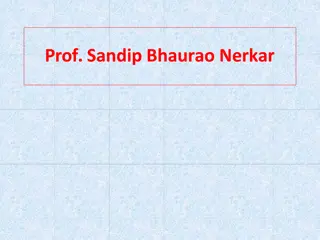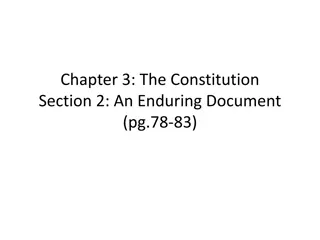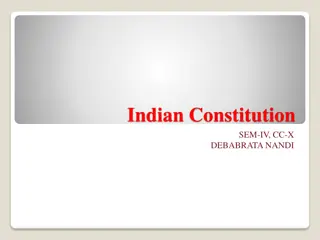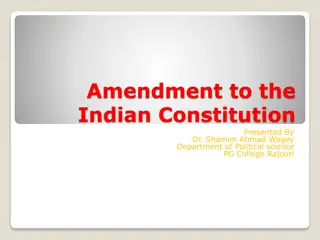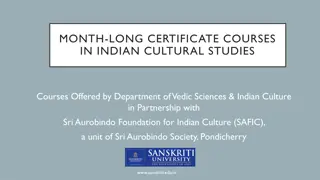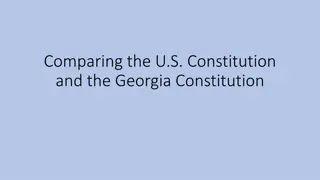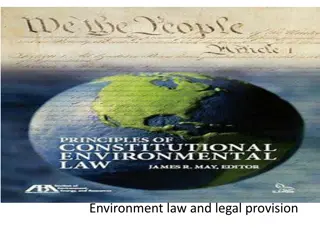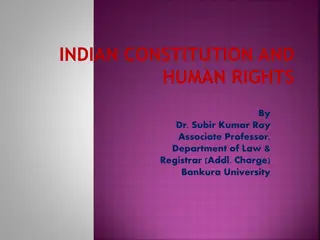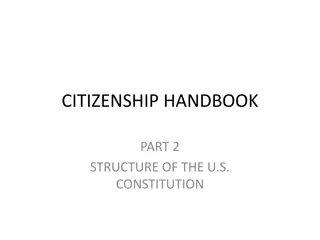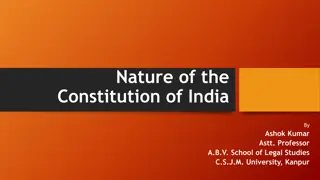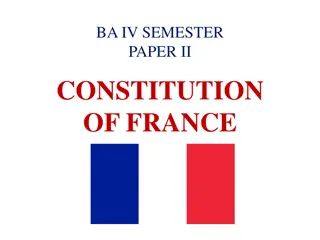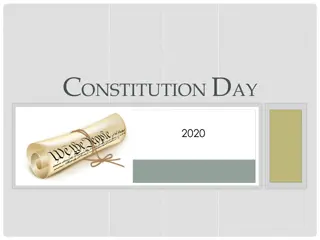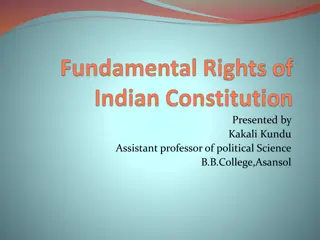Evolution and Key Aspects of the Indian Constitution
The Indian Constitution, evolving from principles of freedom struggle, serves as a set of rules defining citizen-government relations. It generates trust, limits power, and safeguards fundamental principles. Featuring federalism, it establishes governance at three levels: Centre, State, and Local, solidifying India's federal structure.
Download Presentation

Please find below an Image/Link to download the presentation.
The content on the website is provided AS IS for your information and personal use only. It may not be sold, licensed, or shared on other websites without obtaining consent from the author. Download presentation by click this link. If you encounter any issues during the download, it is possible that the publisher has removed the file from their server.
E N D
Presentation Transcript
The Indian Constitution For Class VIII(2020-21) How Does it Evolve? What is a Constitution? Why do we Need a Constitution? Its Salient Features How is it Different from other Constitutions of the World?
How Does It Evolve? Our beloved nation India ie Bharat got independence from British imperialism after a long drawn out struggle for independence that continued for about two centuries. Principles and values that inspired and,in fact, guided the freedom struggle ,formed the foundation for India s democracy. These Ideals and principles are incorporated in the Preamble to the Constitution .
How Does It Evolve? During freedom struggle ,the Indian National Congress in 1934 , made a demand for a Constituent Assembly. During the Second World War ,this assertion for an independent Constituent assembly gained momentum. Finally the Cabinet Mission,1946 sent by the British Government envisaged the establishment of a Constituent Assembly formed of only Indians to draft a Constitution for Free India.
What is a Constitution? The Constitution of India is a set of written rules that are accepted by all the people living together in the country. Constitution is the supreme law that determines the relationship among the citizens and also the relationship between the citizens and government. It is the expression of aspiration of the people(citizens) about creating a good society.
Why do we Need a Constitution? It generates a degree of trust among the citizens to live together. It specifies how government will be constituted and who will have power to take which decisions. It works as the source of power of the government and limits on it.
The Constitution helps us to protect us against certain decisions which are contrary to the fundamental principles that the country believes in.
Salient Features of Our constitution Federalism: In India, we have governments at three levels-Centre ,State and Local levels. The third tier of government ie Local Self Government got constitutional status in 1992. This existence of three tiers of government is the example of federal structure of government.
Salient Features of Our constitution Parliamentary form of Government: The Constitution of India guarantees universal adult suffrage for all its citizens without any discrimination on the ground of age, educational qualifications, sex, race or caste,etc. This means People of India directly elect their representatives for Lok Sabha.Our government has been made responsible to the House of People(Lok Sabha).
Salient Features of Our constitution Separation of Powers: There are three organs of the government viz. executive, legislative and judiciary. Each of the organs exercise different powers . Each organ acts as a check on the other organ and thus this ensures the balance of power between all three.
Salient Features of Our constitution Secularism: India does not promote any religion as the state religion . Rather it respects all religions equally. At the same time it maintains a principled distance from religion. The Indian state works in various ways to prevent inter community and intra community dominations.
Salient Features of Our constitution Fundamental Rights: These are the basic human rights of all citizens . These are enforceable by the courts, subject to specific restrictions. There are six fundamental rights guaranteed to the citizens of India by the Constitution.
Salient Features of Our constitution Fundamental Duties:The Fundamental Duties are incorporated in the Constitution by 42nd Constitutional Amendment Act,1976.Originally there were ten Fundamental Duties and the eleventh duty was added by 86thAmendment Act,2002.Though they are not enforceable by the Court but it is our pious duty to perform our duties towards our Nation because rights and duties are complementary.
How is it Different from other Constitutions of the World? It has several special features that distinguish it from other constitutions of the world. It is a living document. It is open to interpretation . It evolves everyday. It is the lengthiest document in the world. It can adapt itself according to the changing needs of time.
The largest Constitution in the world being signed by the Architect of Independent India, Pt J L Nehru.
Questionnaire 1.What is a Constitution? 2. Why do a country need a Constitution? 3. Discuss the salient features of the Constitution of India. 4. The Constitution of India is a living document. Justify. 5. How can you say the Constitution of India is a unique document? Explain.


